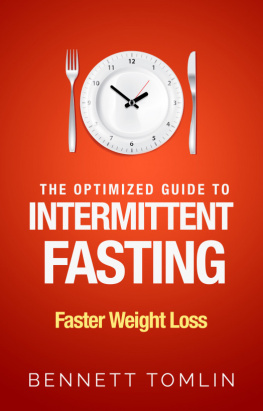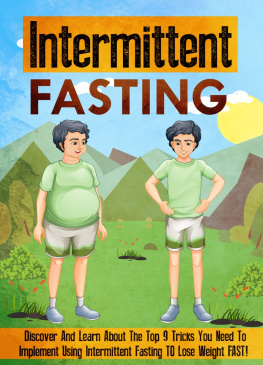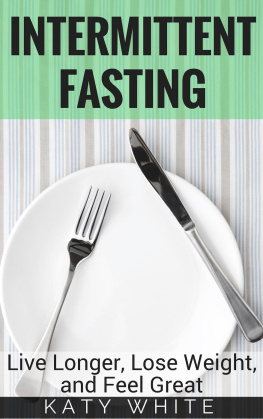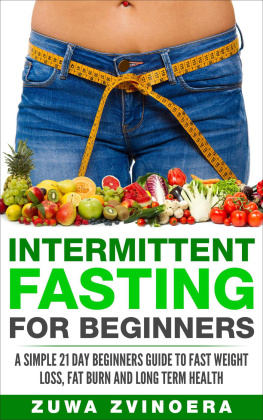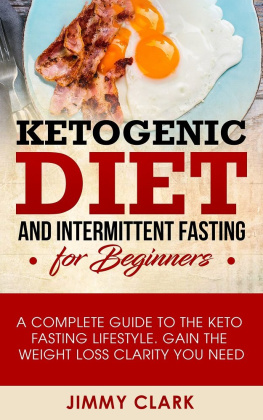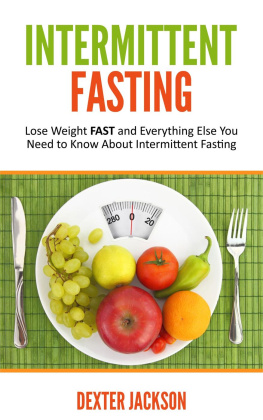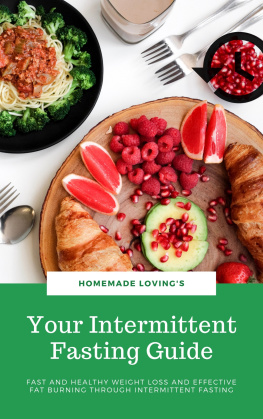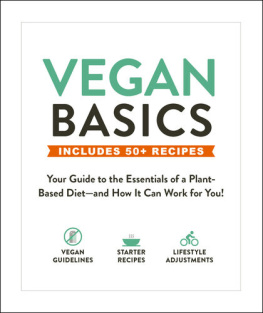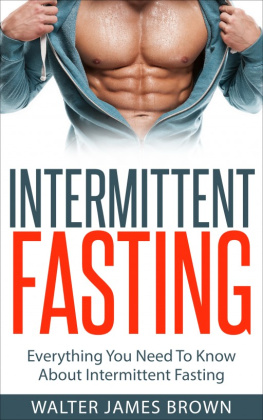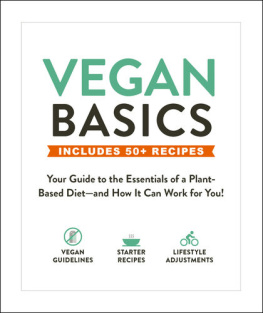The Optimized Guide to IntermittentFasting
BennettTomlin
Published by BennettTomlin at Smashwords
Copyright 2017Bennett Tomlin
Contents
Foreword
I AM NOT A DOCTOR. NOTHING CONTAINED IN THISBOOK IS OR SHOULD BE CONSTRUED AS MEDICAL OR PERSONALIZEDNUTRITIONAL ADVICE. ALWAYS CONSULT WITH A MEDICAL PROFESSIONALBEFORE BEGINNING A DIET OR EXERCISE PROGRAM.
I am sick and tired of diet books. I am sickand tired of diet advice in the news. One minute, we are told that wine helps prevent heart disease; the next,we are told that alcohol is toxic and needs to becut from our lives. I am sick of people telling me what toeat!
That's why I will not do that in this book. Iwill not tell you what to eat at all. I don't care if you eatchocolate cake for every meal (please don't do this). Instead, I amjust going to show you what the newest research shows on when youshould eat, or perhaps, more importantly, when you should noteat.
Most diet books exist because someone istrying to sell something. I have nothing else to sell. This is my one product, and so I have no hidden ulteriormotive. I have never worked for a nutrition orfood production company; the closest I have come is the summer Ispent serving. What I am, instead, is a passionate student of thescientific literature with a desire to figure out the secrets tohealth.
I am not a doctor. I am not a nutritionist.(Yet) I am a biochemistry and pre-medicine double major who spendshis rare free time reading journal articles about these materialsbecause that is what I am passionate about . Ihave a passion for sharing this knowledge. That's why I originallystarted my website Scientific Nutrition ( https://scinutrient.com/ ) and why I have spent timewriting this book. I want everyone to have the knowledge they needfor their health. It is part of why I want to enter the medicalfield.
I hope you enjoy.
Chapter 1
What is intermittentfasting?
Well, it's fasting intermittentlymeaning, itis periods of fasting in which you do not eat, interspersed withperiods of the feast in which you do. This very simple technique of stopping eating is sosimple it almost feels like cheating. There are no secret foods youneed to eat; there is no need to prepare six meals a day; no needto cut out meat or anything else of that sort. It is the simplestdiet stretching back thousands of years.
It was Seneca, thegreat Stoic philosopher, who once said, "Set aside a certain numberof days, during which you shall be content with the scantiest andcheapest fare, with coarse and rough dress, saying to yourself thewhile: 'Is this the condition that I feared?'" Fasting is healingto the spirit and to the body. When we doit, we are proving to ourselves we can survive simply and without some ofthe finer luxuries of life. It is an empoweringexperience.
Even more than that,fasting has been a part of various world cultures and religionsthroughout history. Christians often fast during Lent ; Muslims,during Ramadan; in Judaism, for Yom Kippur. Fasting is not a newpractice! It 's been done for thousands of years.
What was always even more striking for me,though, and the way I judge the fundamental soundness of most dietsis to consider our evolutionary past. Early man would not have hadconsistent access to food until the development of agriculture.What this means for us is that for much of our evolutionaryhistory, we were forced to fast, and because of this, it isreasonable for us to assume that our physiology can handle and mayeven prefer periods of fasting.
Whyshould I fast?
Well, there are many reasons to fast:
1. Weight loss-intermittent fasting has been shown to be an effective method forweight loss. Plus, many people seem to find it much easier to stickto than a regular calorie-restricted diet.
2. Insulin sensitivity- For the millions ofpeople affected by Type 2 diabetes, improving their insulinsensitivity is something that could make a huge difference and evenpotentially save their lives. Intermittent fasting has been shownto improve insulin sensitivity.
3. Cardiovascular disease-intermittent fasting can helpimprove your heart health! Cardiovascular disease is the biggest killer in the United States and amassive killer worldwide. Any technique that promises anyimprovement in this category has huge potential ramifications.However, it is important to remember here that intermittent fastingis not a magic bullet, and although rat and mice studies have shownincredible benefits in this category, it seems that intermittentfasting may not have an extra benefit here over simple calorierestriction. However, many people find this kind of diet easier tostick to, and because of that, it provides a benefit.
4. Brain health- Well, it'stoo early for us to conclusively say that intermittent fasting isbeneficial to the human brain; there are some very promising animal studies that suggest it could. There are also several mechanisms thatI will discuss later in this guide that suggest to me that it couldbenefit brain health.
5. Personal and spiritualgrowth- Throughout history, and as a part of many religions,fasting has existed as a tool for personal and spiritual growth. Itis an exercise in which by not eating, you become more aware ofyour own strength. Many people, aftercompleting their first fast , feel moreempowered. They realize that they can do something that, before,they would have found too challenging.
How doI fast?
You stop eating for a little bit. Fasting isexactly as simple as it sounds. That seems like a glib answer, butI'm trying to emphasize that this truly is a super simpletechnique. Many people make this much more complicated than itneeds to be. I am going to try to avoid that.
How long do I fast?
Now we are gettingsomewhere with our questions. The answer: as long as you want toor, alternatively, as long as is useful to you. The more practicalanswer is that there are many different protocols, and each of themcan be very useful . The one I have used and willdetail here actually uses techniques I have picked up from multipledifferent protocols. I'm going to explain some of the popular protocols in brief right here, and where you can find moreinformation about them. Each of them has been very effective formany people.
The 16:8/LeanGainsprotocol : This is a fasting protocol thatis very popular among certain sets of athletes. It was popularized by MartinBerkhan at leangains.com . He adds somethought about meal timing around workouts and other thoughts, but theprotocol at its most basic is 16 hours of fasting, followed by an8-hour eating windowand during this eating window, you eat threefull meals. This can be a veryeasy protocol for people to stick tobecause it feels less restrictive than many of theothers.
The Eat, Stop, Eatprotocol : This is the protocol popularizedby Brad Pilon in his book Eat, Stop,Eat . This protocol uses 24-hour fastsinterspersed with at least 48 hours of eating. The fasts in thisdiet seem much longer, but it is important to remember thatstructured correctly, this can mean only missing two meals. Forexample, you can do a lunch-to-lunch fast, in which you only missdinner and breakfast.
The 5:2protocol : This is the protocol popularizedin the book The Fast Diet by Dr. Michael Mosley and Mimi Spencer. Thisdiet is focused on five days of normal eating and two days a week ofvery restricted eating ; because there are five normal days aweek, some people enjoy using this diet because it allows them moresocial flexibility.
The 20:4 and OMADprotocols : I'm lumping these two togetherbecause they share many similarities. At their core, they are bothsignificantly more aggressive protocols in terms of total hours spentfasting. In 20:4, you are limited to four hours of eating per day.In OMAD or One Meal A Day, you can eat only a single meal per day.Well, aggressive; both protocols can be quite effective . I am currentlyusing my own variation of the OMAD protocol and have experiencedsignificant weight loss on it.
Next page
